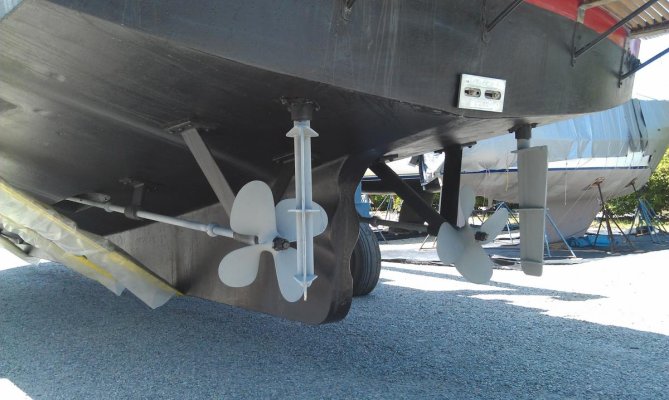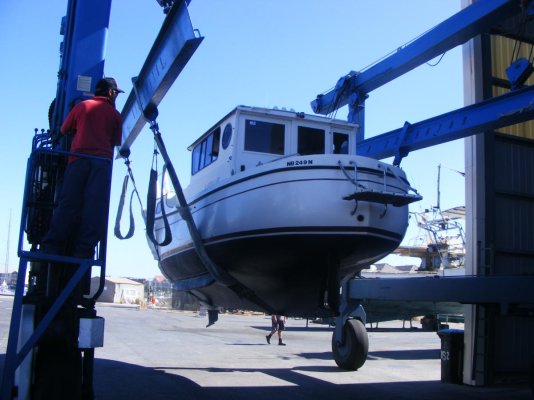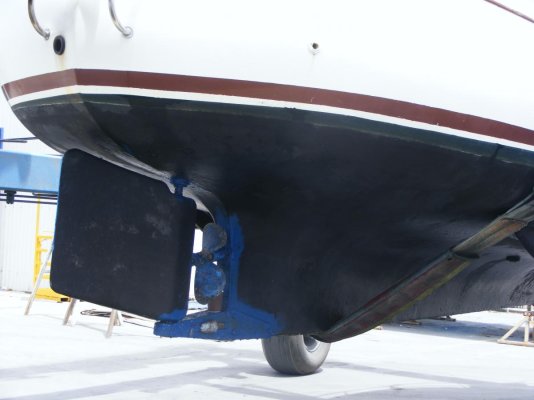With all the discussion of semi-displacement, full displacement, what do the TF'ers consider true displacement models/manufacturers? We keep looking at trawlers, single and twin screw, but most are probably semi-displacement hulls are are probably over powered for the way we like to cruise. We could care less about cruising at 12, 14, 16 or more kts. We are quite happy with 6-7kts. With a semi-displacement hull our fuel burn would be excessive at slower speeds. We keep looking but there seems to be very little available in what we are looking for.
You are using an out of date browser. It may not display this or other websites correctly.
You should upgrade or use an alternative browser.
You should upgrade or use an alternative browser.
True displacement models
- Thread starter Barpilot
- Start date
The friendliest place on the web for anyone who enjoys boating.
If you have answers, please help by responding to the unanswered posts.
If you have answers, please help by responding to the unanswered posts.
healhustler
Guru
- Joined
- Oct 2, 2009
- Messages
- 5,198
- Location
- USA
- Vessel Name
- Bucky
- Vessel Make
- Krogen Manatee 36 North Sea
I believe if you use the "search" option on the menu above, you'll find many thread addressing full-displacement vs. semi-displacement hulls.
Northern Spy
Guru
- Joined
- Feb 5, 2012
- Messages
- 4,075
- Location
- Canada
- Vessel Name
- Northern Spy
- Vessel Make
- Nordic Tug 26
- Joined
- Jun 25, 2008
- Messages
- 10,104
- Location
- Australia
- Vessel Name
- Now boatless - sold 6/2018
- Vessel Make
- Had a Clipper (CHB) 34
It also does not follow that a semi-planing/displacement hull will be less economical at displacment speeds, as that is what most of our vessels are, and we all experience quite low fuel consumption at just under basic hull speed. I am amazed how little fuel we burned over the long easter weekend, and we covered a fair distance, but never at more than 7.5kn.
Last edited:
I'm not interested in a discussion of full vs. semi-displacement. I was looking for any information, based on fact/experience, as to what model/manufacturer are true full displacement. Using the search engine is like searching for a single screw on Yachtworld. You get a list and when you see the actual pictures you quickly find that half of them are twin screw. I'm looking for a true full displacement trawler, 1980 or better, under $150K. Who did or currently makes one?
eyschulman
Guru
- Joined
- Apr 1, 2014
- Messages
- 1,288
Most Nordhavens-Krogens-prety much all the motor sailors- many converted fish boats -many of the older european motor craft particularly Dutch(Lowlands brand) Most Seaton motor boats-most Beuhler designed boats. When you see them out of water it becomes obvious. Many have very bulky deep bottoms. A full displacement boat will carry more weight than Semi but at and under hull speed will be no more efficient and often less efficient do to all the weted surface and heavy weight. FD will ride differently not always better. A SD boat with low or modest power will only travel in full displacement mode and this will cloud the picture. How would we think of a heavy steel boat with a SD under-body shape with small power plant that only travels at 7K? Then there are the lobster boat hulls which in my opinion bridge the gap and travel very well at displacement speed but with power will go faster and have a very long proven track record in tough sea conditions. Are the BEE BEE ocean hoppers SD or FD they were meant to go a long way at 6k? My two cents I would suggest you forget the FD-SD thing and look for a boat that will do what you want performance wise and have the other attributes you wish.
Last edited:
sunchaser
Guru
- Joined
- Apr 9, 2008
- Messages
- 10,195
- Location
- usa
- Vessel Name
- sunchaser V
- Vessel Make
- DeFever 48 (sold)
You get a list and when you see the actual pictures you quickly find that half of them are twin screw. I'm looking for a true full displacement trawler, 1980 or better, under $150K. Who did or currently makes one?
There are many twin screw FD yachts. But, a bit of sleuthing on TF will answer your question in numbing detail, maybe.
Or you could cut to the chase and buy a Willard which no one will ever label anything but FD.
Vashon_Trawler
Guru
- Joined
- Jun 13, 2013
- Messages
- 598
- Location
- USA
- Vessel Name
- M/V Sherpa
- Vessel Make
- 24' Vashon Diesel Cruiser
Willard trawlers come to mind. Look for the thread titled "Need help finding full displacement boat" from 2012--lot's of great suggestions for trawlers in the 40'-45' range. I spent sometime looking for a full displacement pocket trawler (not very common) and fortunately stumbled upon the trawler I now own, which is almost a mini Willard clone under the waterline. I cruise at 6 knots or so and burn as little as 1/2 gallon an hour--I love the sea worthiness and economy!
We looked at a really nice Jefferson 42 (among others we looked at). Coming from living and cruising aboard a sailboat for years, it had all the amenities that we were looking for. What it did have that we couldn't find a use for was 700hp. I just can't imagine ideling all that hp for hours on end without doing damage to the engine or burning copious amounts of fuel.
healhustler
Guru
- Joined
- Oct 2, 2009
- Messages
- 5,198
- Location
- USA
- Vessel Name
- Bucky
- Vessel Make
- Krogen Manatee 36 North Sea
I'm not interested in a discussion of full vs. semi-displacement. I was looking for any information, based on fact/experience, as to what model/manufacturer are true full displacement. Using the search engine is like searching for a single screw on Yachtworld. You get a list and when you see the actual pictures you quickly find that half of them are twin screw. I'm looking for a true full displacement trawler, 1980 or better, under $150K. Who did or currently makes one?
Well then, the thread "Need a list of under 40 displacement boats" has a discussion on what boats can be interpreted as full-displacement hulls. If you're looking for over 40, it'll take another discussion.
- Joined
- Jun 25, 2008
- Messages
- 10,104
- Location
- Australia
- Vessel Name
- Now boatless - sold 6/2018
- Vessel Make
- Had a Clipper (CHB) 34
We looked at a really nice Jefferson 42 (among others we looked at). Coming from living and cruising aboard a sailboat for years, it had all the amenities that we were looking for. What it did have that we couldn't find a use for was 700hp. I just can't imagine ideling all that hp for hours on end without doing damage to the engine or burning copious amounts of fuel.
Ah, yes, that's a whole different aspect. Over-powering is more to be avoided (unless you want fast get-home-out-of-storm-quick type performance potential - not often needed), than the old SD v's FD debate. Sure, the issue of over-powering is more common in SD vessels, but there are plenty of SD hulls out there that are not over-powered - or not by enough to really matter, so I suggest not dismissing an SD vessel out of hand, just because it is not FD, although, having also been an ex-yachtie myself, I can hear what you are saying.
Bay Pelican
Moderator Emeritus
Here is a list of full displacement boats under 40 feet:
Sundowner 30
Fales 32
Pilgrim 40
Lord Nelson 37
Krogen 36
Krogen 39
Nordhavn 40
Willard 40, 36 and 30
Coot
Seahorse Duck 382
Great Harbour GH-37 and N-37
The odd custom Steel Hull Trawler
Prairie 29, not sure about the 36
Schucker 40
Several Defever models over 40 feet are also full displacement.Also I believe the Diesel Ducks are full displacement.
I noted the post that suggested you consider semi-displacement boats. Like everything else in boating, this is in part of question of what you are planning to do with the boat. If you are planning to go off shore - southern Bahamas, Virgins etc. there is a strong argument that full displacement is appropriate. On the Great Lakes or the ICW, semi-displacement would be fine.
Sundowner 30
Fales 32
Pilgrim 40
Lord Nelson 37
Krogen 36
Krogen 39
Nordhavn 40
Willard 40, 36 and 30
Coot
Seahorse Duck 382
Great Harbour GH-37 and N-37
The odd custom Steel Hull Trawler
Prairie 29, not sure about the 36
Schucker 40
Several Defever models over 40 feet are also full displacement.Also I believe the Diesel Ducks are full displacement.
I noted the post that suggested you consider semi-displacement boats. Like everything else in boating, this is in part of question of what you are planning to do with the boat. If you are planning to go off shore - southern Bahamas, Virgins etc. there is a strong argument that full displacement is appropriate. On the Great Lakes or the ICW, semi-displacement would be fine.
Vashon_Trawler
Guru
- Joined
- Jun 13, 2013
- Messages
- 598
- Location
- USA
- Vessel Name
- M/V Sherpa
- Vessel Make
- 24' Vashon Diesel Cruiser
I guess my 24' trawler is too small to make the list! The little guy gets no respect around here! 
FF
Guru
- Joined
- Oct 12, 2007
- Messages
- 22,552
Finding a full displacement hull will assure low fuel consumption (with a right sized engine) and a smoother ride in the rough stuff,
But it will not in any way assure an ocean going/crossing vessel, should that be your interest.
But it will not in any way assure an ocean going/crossing vessel, should that be your interest.
caltexflanc
Guru
Hatteras 42 LRC can be added to the list.
FD boats can be twin screw (see the Hatteras LRC and the Krogen 58 among others)
Suggest a read of Gerr's "The Nature of Boats" to understand the full/planing conundrum. Beebe/Nordhavn's "Voyaging Under Power" discusses why FD is greatly superior, if not virtually required for ocean crossing. Although a guy did take a Fleming across the Atlantic.
I can understand why if you never ever never want to go above displacement speeds, a well designed FD would be desirable, especially for very long voyages. But for coastal cruising, it is just not going to make that huge a difference. My SD Hatt 56, 1300 HP, at 8 knots does not burn significantly more fuel, cost wise, than a FD 58LRC. I did the math, and the premium for the LRC in initial cost was still not recaptured in fuel savings after 10,000 miles. And, "Survey Says!" it didn't hurt those engines one bit.
FD boats can be twin screw (see the Hatteras LRC and the Krogen 58 among others)
Suggest a read of Gerr's "The Nature of Boats" to understand the full/planing conundrum. Beebe/Nordhavn's "Voyaging Under Power" discusses why FD is greatly superior, if not virtually required for ocean crossing. Although a guy did take a Fleming across the Atlantic.
I can understand why if you never ever never want to go above displacement speeds, a well designed FD would be desirable, especially for very long voyages. But for coastal cruising, it is just not going to make that huge a difference. My SD Hatt 56, 1300 HP, at 8 knots does not burn significantly more fuel, cost wise, than a FD 58LRC. I did the math, and the premium for the LRC in initial cost was still not recaptured in fuel savings after 10,000 miles. And, "Survey Says!" it didn't hurt those engines one bit.
Spottsville
Senior Member
- Joined
- May 3, 2012
- Messages
- 265
- Location
- US
- Vessel Name
- Quiet Company
- Vessel Make
- Great Harbour GH-47
All Great Harbour Trawlers are true Full Displacement hulls. All are twin engine with keel protected props and a shallow draft making them great for the Great Loop, inland rivers, ICW shallow areas and ocean capable! Built with quality materials and solid construction.
http://www.greatharbourtrawlers.com
Norm Miller
Quiet Company
Great Harbour GH47
Sent from my iPad using Trawler Forum
http://www.greatharbourtrawlers.com
Norm Miller
Quiet Company
Great Harbour GH47
Sent from my iPad using Trawler Forum
Last edited:
Daddyo
Guru
Sorry to confuse but there is something called semi that is actually full-displacement. Our DeFever is called semi-displacement but it really isn't, If you look at how deep she is in the belly with the hull angle moving aft, the curve of the deadrise and the fuel burn of 1.9gph at 6.8knots for a 60K boat with no wake seems to bear that out.
Attachments
Phil Fill
Guru
- Joined
- Oct 11, 2007
- Messages
- 2,919
- Location
- US
- Vessel Name
- Eagle
- Vessel Make
- Roughwater 58 pilot house
A very small % of power/motor boats are full displacment: Norhaven, Selen, Krogen, North Marine, Diesel Duck, Molonki Strait. Cape Horn, LR Hatteras, older Willards, Vick Franc/gardner and roughwaters, and a few off brands. Ocean Alexander and Defever has made some semi displacment with small engine so they can only go hull speed. Grand Alaska, Outer Reef and Flemming are sort of. Most of the true full displament are high priced/quality boats as they are mainly blue water boats.
Nomad Willy
Guru
Barpilot,
Since you've been a sailboater you know that most all sailboats have their transom up above the water. That will identify a FD hull.
The QBBL (quarter beam buttock line) can identify the FD boats that have a bit of submerged transom. Two or three inches. The QBBL is a line that is in-between the keel line aft and the chine. If that line is anywhere near flat or horizontal like a lot of the DeFevers it's a SD hull. SD hulls like the DeFevers that are quite close to a FD hull are even more rare than the FD type. Most trawlers are from about in the middle between FD and SD to closer to planing like the IG. Note I said closER. I believe the CHB is a little closer to FD as their keel line is steeper than most so the quarter beam line (in the middle(quarter beam)) between the keel line and the chine line will hence be a bit steeper. Many or possibly most trawlers have a fairly straight chine line aft but the keel line is considerably steeper. The difference between the two is the QBBL.
The Krogens and the Willard 40 should be in your ballpark and most everybody here probably would highly recommend them. Check the Willard web site as I believe there is a pristine W40 available.
The drag of the SD hull will fall generally between 1.3 to 1.7 depending mostly on the QBBL and the amount of submerged transom. That is just an educated opinion or guess and some would/will argue about it. I think a FP hull would fall in the range of 1.5 to 2 or 3 times the drag of a FD hull. The wide range depends heavily on such factors as displacement, beam, deadrise, wetted surface and weight distribution. Some high speed deep V hulls have their weight biased so far aft (for high speed benefits) their drag could be 5 to 10 times of a FD hull but of course it's meaningless as they don't go 6 knots and only need enough power to get past the FD point.
Craig's smallish (26'?) relatively light planing hull will have less drag (per ton of disp) for it's size than most trawlers due to it's light weight. And conversely many FD hulls eat up their efficiency advantage being too heavy.
Marty,
Excellent list except for the sin of overlooking our resident Vashon Trawler. And Barpilot look on YW for the boats that don't fit neatly into the brand box. You'll be especially likely to find steel hulls and other custom boats. You'll find features in custom boats you'll never find in production boats.
eyschulman,
Clearly the best post for advice … excellent. But you may be over rating the lobster boat in that they are IMO much closer to a planing boat and probably require 2x+ the power of a FD. Don't be fooled by those soft chines. Every lobster boat I've ever seen has a mountain of water following them around.
Since you've been a sailboater you know that most all sailboats have their transom up above the water. That will identify a FD hull.
The QBBL (quarter beam buttock line) can identify the FD boats that have a bit of submerged transom. Two or three inches. The QBBL is a line that is in-between the keel line aft and the chine. If that line is anywhere near flat or horizontal like a lot of the DeFevers it's a SD hull. SD hulls like the DeFevers that are quite close to a FD hull are even more rare than the FD type. Most trawlers are from about in the middle between FD and SD to closer to planing like the IG. Note I said closER. I believe the CHB is a little closer to FD as their keel line is steeper than most so the quarter beam line (in the middle(quarter beam)) between the keel line and the chine line will hence be a bit steeper. Many or possibly most trawlers have a fairly straight chine line aft but the keel line is considerably steeper. The difference between the two is the QBBL.
The Krogens and the Willard 40 should be in your ballpark and most everybody here probably would highly recommend them. Check the Willard web site as I believe there is a pristine W40 available.
The drag of the SD hull will fall generally between 1.3 to 1.7 depending mostly on the QBBL and the amount of submerged transom. That is just an educated opinion or guess and some would/will argue about it. I think a FP hull would fall in the range of 1.5 to 2 or 3 times the drag of a FD hull. The wide range depends heavily on such factors as displacement, beam, deadrise, wetted surface and weight distribution. Some high speed deep V hulls have their weight biased so far aft (for high speed benefits) their drag could be 5 to 10 times of a FD hull but of course it's meaningless as they don't go 6 knots and only need enough power to get past the FD point.
Craig's smallish (26'?) relatively light planing hull will have less drag (per ton of disp) for it's size than most trawlers due to it's light weight. And conversely many FD hulls eat up their efficiency advantage being too heavy.
Marty,
Excellent list except for the sin of overlooking our resident Vashon Trawler. And Barpilot look on YW for the boats that don't fit neatly into the brand box. You'll be especially likely to find steel hulls and other custom boats. You'll find features in custom boats you'll never find in production boats.
eyschulman,
Clearly the best post for advice … excellent. But you may be over rating the lobster boat in that they are IMO much closer to a planing boat and probably require 2x+ the power of a FD. Don't be fooled by those soft chines. Every lobster boat I've ever seen has a mountain of water following them around.
Last edited:
ranger58sb
Guru
Hatteras 42 LRC can be added to the list.
FD boats can be twin screw (see the Hatteras LRC and the Krogen 58 among others)
Didn't know Hatteras LRCs were full displacement...
-Chris
Nomad Willy
Guru
Didn't know Hatteras LRCs were full displacement...
-Chris
I don't think they are but not very familiar w the Hats.
AusCan,
I thought about trying to come up w a list and was glad Marty bellied up to the bar as I was sure I'd get into trouble missing someone important like AusCan. And of course there's no question about being FD.
I wonder if there's any other FD boat that got overlooked. Not all would pop up and say "hey you forgot me". Good on ya Chris.
caltexflanc
Guru
Didn't know Hatteras LRCs were full displacement...
-Chris
Yep. Will not plane, hull speed is max.
caltexflanc
Guru
Sorry to confuse but there is something called semi that is actually full-displacement. Our DeFever is called semi-displacement but it really isn't, If you look at how deep she is in the belly with the hull angle moving aft, the curve of the deadrise and the fuel burn of 1.9gph at 6.8knots for a 60K boat with no wake seems to bear that out.
Compare your chine and the (lack of) roundness of your boats bottom with that of the sailboat in the back of your photo.
ranger58sb
Guru
Yep. Will not plane, hull speed is max.
They don't have hard chines? I thought they were simply powered appropriately for LRC'ing (so to speak)... but also thought 12v92s or some such (if so powered) would make 'em lift a bit...
Not an argument, just a question.
-Chris
caltexflanc
Guru
They don't have hard chines? I thought they were simply powered appropriately for LRC'ing (so to speak)... but also thought 12v92s or some such (if so powered) would make 'em lift a bit...
Not an argument, just a question.
-Chris
Nope, nope and nope. The LRCs have mostly, 4 or some 6 cylinder engines, usually 53 series Detroit. Even the largest, the 65 only had 6-71s in them.
I once had my boat in the yard with a 58LRC on the hard right near by. Definitely a different form factor with much softer chines, and a roundish bottom that flattened a bit aft.
caltexflanc
Guru
BTW, i got distracted. Wanted to post this picture of a "hard" chined trawler, rounded in a different way.
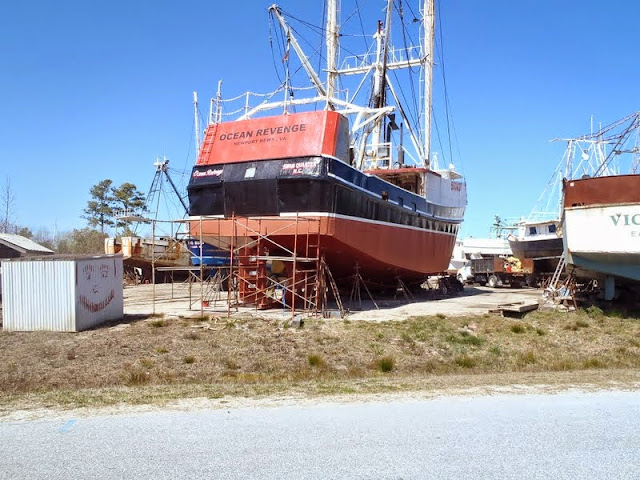
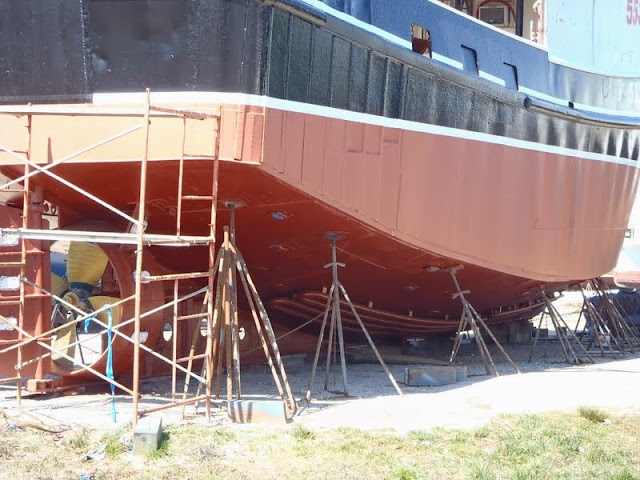
Note that this Bering emulates this approach, kind of:


Note that this Bering emulates this approach, kind of:
Similar threads
- Replies
- 97
- Views
- 9K


